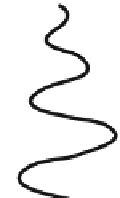Biomedical Engineering Reference
In-Depth Information
inverse Hexagonal (H
II
)
Planar bilayer Micelle
Fig. 3.4
Schematicmodel for altering bilayer physical properties by lipids or small amphiphiles [
4
].
In the
upper panel
, three basic shapes of molecules considering the relative head group-tail geometry
are shown to determine cylindrical, conical, and inverted conical type structures, respectively. In
the
bottom panel
, the resulting induced structures, which are planar bilayer, micelle, and inverse
hexagonal phases are presented. The above-mentioned cylindrical, conical, and inverse conical
molecule structures account for neutral, positive, and negative curvatures, respectively, which favor
different lipid organizations as shown here
assumes that the lipid phase behavior is largely the result of a competition between the
tendency for certain lipid monolayers to curl, and the hydrocarbon packing strains.
In lipid molecules, the relative head group versus tail geometry is in fact respon-
sible for favoring different lipid orientations which determine the curvature stress.
As a result, bilayer formation, micelle structure, or inverse hexagonal structure, etc.,
emerge. This is schematically shown in Fig.
3.4
.
The quantitative measure of the tendency of a monolayer to curl comes from
the consideration of the lipid's intrinsic radius of curvature. The lipid's intrinsic
curvature determines the monolayer bending energy, which clearly depends on the
flexibility of the lipid layer, also referred to as the elasticity of a lipid monolayer. The
geometrical structure, chemical composition, etc., which are specific inherited lipid
properties, determine the elastic constants associated with the corresponding lipid
layer. That is why the lipid organization in a biological environment is also
lipid-specific. For instance, the lipid palmitoyl oleyl phosphatidyl choline (POPC)
tends to form lamellar vesicles in solution, whereas smaller lipids with shorter acyl






















































































































































Search WWH ::

Custom Search